|
|
|
Sort Order |
|
|
|
Items / Page
|
|
|
|
|
|
|
| Srl | Item |
| 1 |
ID:
191376


|
|
|
|
|
| Summary/Abstract |
The government of Israel has announced its plan to introduce a national carbon price of ILS 130 (∼USD 40) per ton of CO2 in 2023. In this study, we analyse the subsequent distributional impacts on Israeli households. We build on the recent Household Budget Survey from 2018 compiled by the Israeli Central Bureau of Statistics and merge this data with sector-specific embedded carbon intensities derived from multi-regional input-output data. We find that without further measures a carbon price would have regressive effects on Israeli households. Using statistical analyses we show that rural households, Arab households or households that own (and use) a car would face additional costs above average. Redistributing revenues from carbon pricing could help to address socially unbalanced and unintended outcomes. We model various redistribution schemes after iterating with Israeli stakeholders. Compensating households with lump sum transfers or (partially) subsidizing electricity consumption could lead to progressive outcomes, while proposed policies to lower existing transport fuel taxes would exacerbate regressive distributional effects.
|
|
|
|
|
|
|
|
|
|
|
|
|
|
|
|
| 2 |
ID:
192771


|
|
|
|
|
| Summary/Abstract |
The government of Israel has announced its plan to introduce a national carbon price of ILS 130 (∼USD 40) per ton of CO2 in 2023. In this study, we analyse the subsequent distributional impacts on Israeli households. We build on the recent Household Budget Survey from 2018 compiled by the Israeli Central Bureau of Statistics and merge this data with sector-specific embedded carbon intensities derived from multi-regional input-output data. We find that without further measures a carbon price would have regressive effects on Israeli households. Using statistical analyses we show that rural households, Arab households or households that own (and use) a car would face additional costs above average. Redistributing revenues from carbon pricing could help to address socially unbalanced and unintended outcomes. We model various redistribution schemes after iterating with Israeli stakeholders. Compensating households with lump sum transfers or (partially) subsidizing electricity consumption could lead to progressive outcomes, while proposed policies to lower existing transport fuel taxes would exacerbate regressive distributional effects.
|
|
|
|
|
|
|
|
|
|
|
|
|
|
|
|
| 3 |
ID:
191393


|
|
|
|
|
| Summary/Abstract |
The implementation of China's energy-consumption permit trading scheme (ECPTS) is a recent initiative to accelerate energy transition towards carbon neutrality; however, its impacts on the economy and environment have not been well studied. A dynamic stochastic general equilibrium (DSGE) model is employed to estimate the macroeconomic effect of the ECPTS. The results show that in the short term, the ECPTS could obtain environmental dividends but fails to achieve the “Porter” effect, and its energy-saving effect is only significant over the long run. When combined with the implementation of carbon tax, the negative impact of the ECPTS on final output could be narrowed but a long-term loss of social welfare is inevitable due to labor transfer costs between energy firms. Moreover, a low-carbon energy structure could weaken the macroeconomic effect of the ECPTS, which is in line with expectations as China's energy transition aims to achieve large-scale development of renewable energy. The findings support the Chinese government to expand the regional coverage of the ECPTS and explore a coordination mechanism with carbon pricing policy. The government is also suggested to improve the legislation and supporting measures of the ECPTS to weaken its negative impact on the macroeconomy.
|
|
|
|
|
|
|
|
|
|
|
|
|
|
|
|
| 4 |
ID:
191391


|
|
|
|
|
| Summary/Abstract |
The increasing frequency of extreme weather events forced policymakers to take stricter commitments to mitigate climate change. The household sector, which is responsible for one-third of greenhouse gas (CO2) emissions is also important when mitigating climate change. However, there is still a lack of research which analyzes the changes in electricity and energy for heating consumption and CO2 emissions caused. Furthermore, the aim of this paper is to analyze the determinants such as: environmental awareness (knowledge about the environment, attitudes towards energy behavior, and pro-environmental behavior), climate change policy (renovations, choice of green electricity supplier) and social-demographic variables of electricity, energy for heating, electricity consumption and CO2 pollution caused in 2022 in Lithuania. The results showed that energy for heating consumption and CO2 emissions caused decreased significantly from 2017 to 2022. Meanwhile, electricity consumption increased but CO2 pollution caused changed insignificantly. From the main determinants, only education level significantly and negatively affected electricity consumption and its carbon dioxide emissions. Environmental knowledge and pro-environmental behavior significantly and positively influenced electricity consumption and its pollution. Energy consumption for heating significantly and negatively depended on education level, environmental knowledge, and renovation level. Meanwhile, renovation and choice of green electricity supplier significantly and negatively determined carbon dioxide emissions caused by energy consumption for heating. Thus, these results confirmed the importance of climate change policy implementation, particularly the promotion of renovation processes, and renewable energy consumption.
|
|
|
|
|
|
|
|
|
|
|
|
|
|
|
|
| 5 |
ID:
191387


|
|
|
|
|
| Summary/Abstract |
The number of crises experienced around the world forces people to reconsider and reassess various aspects of their lives. The energy crisis caused by the war in Ukraine and uncontrolled climate change revealed the importance of energy-saving behavior. Thus, the aim of this paper is to analyze the concerns about current crises such as the Covid-19 pandemic, the war in Ukraine, and climate change's impact on energy-saving behavior and changes in environmental concern. Referring to the survey conducted in Lithuania in 2022, where 1000 respondents participated, the results revealed that the war in Ukraine was the most concerning problem. The level of climate change concern was slightly lower. Meanwhile, the Covid-19 pandemic was the least important problem in Lithuania in 2022. Furthermore, respondents stated that the Covid-19 pandemic contributed to the changes in environmental concern and energy-saving actions more than the war in Ukraine did. Meanwhile, the Generalized Linear Model results revealed that only the war in Ukraine positively and significantly influenced energy-saving behavior. The Covid-19 pandemic concern negatively affected energy-saving behavior, while the climate change concern factor affected it indirectly, as the interaction of attitudes toward energy consumption. Thus, this study revealed the main aspect of and how to encourage energy-saving behavior in the context of the main current crises.
|
|
|
|
|
|
|
|
|
|
|
|
|
|
|
|
| 6 |
ID:
191371


|
|
|
|
|
| Summary/Abstract |
Greener alternatives for fuelling automobiles, such as hydrogen transport and electric vehicles, have shown considerable promise in transportation. Many others are sceptical of the growing enthusiasm for these new technologies, believing that energy storage technologies and management are insufficient for a complete shift. Such a network of variables and smart grid technologies that can help with the transition may reveal some systemic hazards linked with financial institutions, company risk and failure, and so on. This study attempts to characterise spillovers and connections between the indices of green transportation, smart grid, innovative materials, energy storage, and energy management globally. To do this, we employ a novel strategy developed by Balcilar et al. (2021) as well as a robustness check using the well-known Diebold and Yilmaz (2012) method. The study highlights the sub-systemic sector's connections, giving policymakers insights into instruments to support financial market sustainability and stability. It would be critical to separate the impact of these indicators, but given the intrinsic relationship, this would be nearly impossible. The transportation innovation network is not rigid and established in its interconnection. The role of indicators shifts from transmitting to absorbing shocks regularly, and policymakers who want to encourage long-term solutions must be aware of this.
|
|
|
|
|
|
|
|
|
|
|
|
|
|
|
|
| 7 |
ID:
192766


|
|
|
|
|
| Summary/Abstract |
Greener alternatives for fuelling automobiles, such as hydrogen transport and electric vehicles, have shown considerable promise in transportation. Many others are sceptical of the growing enthusiasm for these new technologies, believing that energy storage technologies and management are insufficient for a complete shift. Such a network of variables and smart grid technologies that can help with the transition may reveal some systemic hazards linked with financial institutions, company risk and failure, and so on. This study attempts to characterise spillovers and connections between the indices of green transportation, smart grid, innovative materials, energy storage, and energy management globally. To do this, we employ a novel strategy developed by Balcilar et al. (2021) as well as a robustness check using the well-known Diebold and Yilmaz (2012) method. The study highlights the sub-systemic sector's connections, giving policymakers insights into instruments to support financial market sustainability and stability. It would be critical to separate the impact of these indicators, but given the intrinsic relationship, this would be nearly impossible. The transportation innovation network is not rigid and established in its interconnection. The role of indicators shifts from transmitting to absorbing shocks regularly, and policymakers who want to encourage long-term solutions must be aware of this.
|
|
|
|
|
|
|
|
|
|
|
|
|
|
|
|
| 8 |
ID:
191396


|
|
|
|
|
| Summary/Abstract |
Unprecedented investments in clean energy technology are required for a net-zero carbon energy system before temperatures breach the Paris Agreement goals. By performing a Monte-Carlo Analysis with the detailed ETSAP-TIAM Integrated Assessment Model and by generating 4000 scenarios of the world's energy system, climate and economy, we find that the uncertainty surrounding technology costs, resource potentials, climate sensitivity and the level of decoupling between energy demands and economic growth influence the efficiency of climate policies and accentuate investment risks in clean energy technologies. Contrary to other studies relying on exploring the uncertainty space via model intercomparison, we find that the CO2 emissions and CO2 prices vary convexly and nonlinearly with the discount rate and climate sensitivity over time. Accounting for this uncertainty is important for designing climate policies and carbon prices to accelerate the transition. In 70% of the scenarios, a 1.5 °C temperature overshoot was within this decade, calling for immediate policy action. Delaying this action by ten years may result in 2 °C mitigation costs being similar to those required to reach the 1.5 °C target if started today, with an immediate peak in emissions, a larger uncertainty in the medium-term horizon and a higher effort for net-zero emissions.
|
|
|
|
|
|
|
|
|
|
|
|
|
|
|
|
| 9 |
ID:
191369
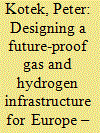

|
|
|
|
|
| Summary/Abstract |
Hydrogen has been at the centre of attention since the EU kicked-off its decarbonization agenda at full speed. Many consider it a silver bullet for the deep decarbonization of technically challenging sectors and industries, but it is also an attractive option for the gas industry to retain and future-proof its well-developed infrastructure networks. The modelling methodology presented in this report systematically tests the feasibility and cost of different pipeline transportation methods – blending, repurposing, and dedicated hydrogen pipelines - under different decarbonization pathways and concludes that blending is not a viable solution and pipeline repurposing can lead to excessive investment outlays in the range of EUR 19–25 bn over the modelled period (2020–2050) for the EU-27.
|
|
|
|
|
|
|
|
|
|
|
|
|
|
|
|
| 10 |
ID:
192764
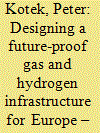

|
|
|
|
|
| Summary/Abstract |
Hydrogen has been at the centre of attention since the EU kicked-off its decarbonization agenda at full speed. Many consider it a silver bullet for the deep decarbonization of technically challenging sectors and industries, but it is also an attractive option for the gas industry to retain and future-proof its well-developed infrastructure networks. The modelling methodology presented in this report systematically tests the feasibility and cost of different pipeline transportation methods – blending, repurposing, and dedicated hydrogen pipelines - under different decarbonization pathways and concludes that blending is not a viable solution and pipeline repurposing can lead to excessive investment outlays in the range of EUR 19–25 bn over the modelled period (2020–2050) for the EU-27.
|
|
|
|
|
|
|
|
|
|
|
|
|
|
|
|
| 11 |
ID:
192762


|
|
|
|
|
| Summary/Abstract |
The purpose of this paper is to explore the determinants that promote the replacement of water heaters with more energy efficient models (e.g., gas or electricity-based energy efficient water heaters). By using survey data on Japanese households' water heater choice collected from an online questionnaire, this paper examines the effect of peers, choice context, and households’ perception of energy sources. The following results are obtained: First, households tend to choose gas or electricity-based energy efficient water heaters which, at the point when the households start to consider replacement, are known to have been used by peers (peer effect). Second, households are more likely to choose a gas or electricity-based energy efficient water heater in the context where they simultaneously replace their water heater and other home facilities (context effect). Finally, as for electricity-based energy efficient water heaters, households with a positive (negative) perception of electricity are more (less) likely to choose an electricity-based energy efficient water heater (perception of energy sources). These results imply the importance of considering these factors when designing policy instruments to promote the adoption of energy efficient water heaters in the residential sector.
|
|
|
|
|
|
|
|
|
|
|
|
|
|
|
|
| 12 |
ID:
191367


|
|
|
|
|
| Summary/Abstract |
The purpose of this paper is to explore the determinants that promote the replacement of water heaters with more energy efficient models (e.g., gas or electricity-based energy efficient water heaters). By using survey data on Japanese households' water heater choice collected from an online questionnaire, this paper examines the effect of peers, choice context, and households’ perception of energy sources. The following results are obtained: First, households tend to choose gas or electricity-based energy efficient water heaters which, at the point when the households start to consider replacement, are known to have been used by peers (peer effect). Second, households are more likely to choose a gas or electricity-based energy efficient water heater in the context where they simultaneously replace their water heater and other home facilities (context effect). Finally, as for electricity-based energy efficient water heaters, households with a positive (negative) perception of electricity are more (less) likely to choose an electricity-based energy efficient water heater (perception of energy sources). These results imply the importance of considering these factors when designing policy instruments to promote the adoption of energy efficient water heaters in the residential sector.
|
|
|
|
|
|
|
|
|
|
|
|
|
|
|
|
| 13 |
ID:
191397


|
|
|
|
|
| Summary/Abstract |
Green finance is important in carbon reduction, but few studies pay attention to Green Credit Policy (GCP). This study examines the relationship between GCP and CO2 emissions of Chinese heavily polluting enterprises (HPEs). Taking the implementation of Green Credit Guidelines (GCG) as a quasi-natural experiment, we design a Difference-in-Difference (DID) model using panel data. The evidence reveals that GCG can indirectly decrease CO2 emissions by increasing financing costs and improving technical efficiency. Further studies find that companies with non-state background, medium-sized companies and companies in eastern regions are more sensitive to the policy. The paper provides policy implications for building a green financial system and supporting endeavors to achieve carbon peak and carbon neutrality.
|
|
|
|
|
|
|
|
|
|
|
|
|
|
|
|
| 14 |
ID:
191366
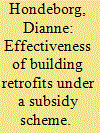

|
|
|
|
|
| Summary/Abstract |
While retrofitting buildings is one of the key elements of reaching climate and energy goals, it is burdened by insufficient speed and depth. Governments have attempted to accelerate deep retrofits via subsidies, but scant evidence exists on these policies’ effectiveness. In this study, we investigate the effectiveness of retrofitting subsidies by using a range of econometric techniques and a unique dataset of over 400 Swiss buildings with 19,000 observations over 11 years. Specifically, we analyze whether retrofits reduce energy consumption, whether subsidized retrofits lead to deeper retrofits than non-subsidized retrofits, and we differentiate the impact by subsidy amount. We find that retrofits reduce average energy use by 10–20%, that the achieved savings through subsidized and non-subsidized retrofits do not differ significantly, and that the subsidy amount is correlated to a reduction in energy use by 0.42 CHF per kWh over a period of 20 years. Our study highlights the importance of policies that enhance retrofit depth, the need to further investigate the causes of the wide variation in retrofitting results, and to consider effectiveness studies within the policy design.
|
|
|
|
|
|
|
|
|
|
|
|
|
|
|
|
| 15 |
ID:
192761
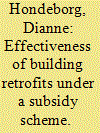

|
|
|
|
|
| Summary/Abstract |
While retrofitting buildings is one of the key elements of reaching climate and energy goals, it is burdened by insufficient speed and depth. Governments have attempted to accelerate deep retrofits via subsidies, but scant evidence exists on these policies’ effectiveness. In this study, we investigate the effectiveness of retrofitting subsidies by using a range of econometric techniques and a unique dataset of over 400 Swiss buildings with 19,000 observations over 11 years. Specifically, we analyze whether retrofits reduce energy consumption, whether subsidized retrofits lead to deeper retrofits than non-subsidized retrofits, and we differentiate the impact by subsidy amount. We find that retrofits reduce average energy use by 10–20%, that the achieved savings through subsidized and non-subsidized retrofits do not differ significantly, and that the subsidy amount is correlated to a reduction in energy use by 0.42 CHF per kWh over a period of 20 years. Our study highlights the importance of policies that enhance retrofit depth, the need to further investigate the causes of the wide variation in retrofitting results, and to consider effectiveness studies within the policy design.
|
|
|
|
|
|
|
|
|
|
|
|
|
|
|
|
| 16 |
ID:
191384
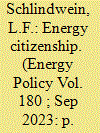

|
|
|
|
|
| Summary/Abstract |
According to the European Green Deal, achieving energy transition, which aims to establish a shift towards a more sustainable and low-carbon energy system, requires the active participation of citizens. Consequently, the concept of energy citizenship has emerged as a means of understanding the role of citizens in this process. This study conducts an integrative literature review with the objective of providing a comprehensive definition of energy citizenship and distinguishing between different types of energy citizens based on their engagement within the energy system. Six different types of energy citizens (i.e., consumer; prosumer and prosumager; participant in protests and movements; policymaker; business entity; and energy community), acting as either individuals or as collective entities or both, have been defined. This differentiation highlights the heterogeneity of human behaviours within energy transition. We argue that policymaking aimed at fostering energy transition should consider the behavioural dimensions of all types of energy citizens. In order to effectively support a fair, inclusive, and just energy transition, policy measures and intervention instruments need to account for various barriers, drivers as well as the socio-economic context of the diverse stakeholders participating in innovation ecosystems.
|
|
|
|
|
|
|
|
|
|
|
|
|
|
|
|
| 17 |
ID:
191379


|
|
|
|
|
| Summary/Abstract |
Identifying the policy effect of government subsidies on families is beneficial to alleviate household energy poverty. This study first builds a Propensity Score Matching–Difference-in-Differences (PSM-DID) model and empirically tests the impact of government subsidies on household energy poverty in China based on China Family Panel Studies data from 2016 to 2018. The results show that household energy poverty is considered to have obvious regional differences. Moreover, the results indicate that government subsidies can reduce the probability of household energy poverty by 38.1%. However, the effect of government subsidies in alleviating household energy poverty will vary depending on the specific household situation. It is concluded that subsidies provided by the Chinese government to households can effectively alleviate household energy poverty. Finally, some policy recommendations are proposed based on the results of the empirical analysis.
|
|
|
|
|
|
|
|
|
|
|
|
|
|
|
|
| 18 |
ID:
191368


|
|
|
|
|
| Summary/Abstract |
Electric vehicles (EVs) can play an ancillary role in energy and electricity system management. Vehicle-to-Grid (V2G) technology allows EV batteries to be discharged back into the grid. This technology enables charging when electricity prices are low and there is abundance of electricity in the grid and discharging when electricity costs are high and there is high load in the grid. The current study estimates the combination of financial compensation (FC) incentives (reduction in monthly electricity bill) and minimum guaranteed charge (MC) that would be needed to increase the acceptance of V2G technology among Norwegians. Estimating a multi-equation econometric model, we investigate how socioeconomic, geographical, and psychological exogenous variables predict the level of FC and required MC, as well as the relationship between FC and MC. We found that there is a mutual and negative relationship between FC and MC. Based on the MC-FC economic relationship, the V2G system is more likely to be accepted by older people, people who perceive the V2G system as more useful, people who have EV experience, and individuals with a higher level of trust in the V2G system. The group with strong trust in V2G demands less FC for a given value of MC. When MC is reduced, younger age groups (18–22) are more likely to demand higher FC. Our estimations also show that people demand an average reduction in electricity bills of 144 USD (72% of the average monthly electricity bill) as compensation for V2G investment while they would also use V2G if their electric car’s battery had a minimum level of 71% power. Monetary incentives based on socioeconomic status, options in the interface allowing the user to easily override the standards, and trusted methods of calculating the revenue may be considered in order to reduce financial expectations and concerns regarding minimum battery charges.
|
|
|
|
|
|
|
|
|
|
|
|
|
|
|
|
| 19 |
ID:
192763


|
|
|
|
|
| Summary/Abstract |
Electric vehicles (EVs) can play an ancillary role in energy and electricity system management. Vehicle-to-Grid (V2G) technology allows EV batteries to be discharged back into the grid. This technology enables charging when electricity prices are low and there is abundance of electricity in the grid and discharging when electricity costs are high and there is high load in the grid. The current study estimates the combination of financial compensation (FC) incentives (reduction in monthly electricity bill) and minimum guaranteed charge (MC) that would be needed to increase the acceptance of V2G technology among Norwegians. Estimating a multi-equation econometric model, we investigate how socioeconomic, geographical, and psychological exogenous variables predict the level of FC and required MC, as well as the relationship between FC and MC. We found that there is a mutual and negative relationship between FC and MC. Based on the MC-FC economic relationship, the V2G system is more likely to be accepted by older people, people who perceive the V2G system as more useful, people who have EV experience, and individuals with a higher level of trust in the V2G system. The group with strong trust in V2G demands less FC for a given value of MC. When MC is reduced, younger age groups (18–22) are more likely to demand higher FC. Our estimations also show that people demand an average reduction in electricity bills of 144 USD (72% of the average monthly electricity bill) as compensation for V2G investment while they would also use V2G if their electric car’s battery had a minimum level of 71% power. Monetary incentives based on socioeconomic status, options in the interface allowing the user to easily override the standards, and trusted methods of calculating the revenue may be considered in order to reduce financial expectations and concerns regarding minimum battery charges.
|
|
|
|
|
|
|
|
|
|
|
|
|
|
|
|
| 20 |
ID:
192760


|
|
|
|
|
| Summary/Abstract |
Transition to a low carbon economy has a unique set of circumstances which present both challenges and opportunities for the development of its energy policies and require customised energy planning solutions and policies. Each country begins its path to decarbonization from a different starting point. The Northern Territory (NT) of Australia has one of the highest rates of solar insolation in Australia which can be a catalyst for future energy development. This study explores the potential for long-range renewable energy (RE) planning and climate policies for the NT to transition to a low-carbon economy by 2050, while achieving sustainable economic growth by analysing three scenarios: business-as-usual (BAU), High Industry Growth (HIG) and Renewable Energy Export (REE). The results showed that slight variations in inputs and assumptions can affect the need and timing of appropriate policies to support a desired outcome or goal. In conclusion, a low-emissions economy based on an industry powered by renewable energy is possible with the support of a range of effectively timed energy and climate policies. Effective energy transition policies would need to be developed with careful consideration of the unique circumstances and existing barriers in the NT. The future could be a combination of elements in both HIG scenario and a REE scenario. If implemented and sequenced appropriately, energy policies can be effective in laying the groundwork for a smoother transition to low-carbon economy in the NT.
|
|
|
|
|
|
|
|
|
|
|
|
|
|
|
|
|
|
|
|
|